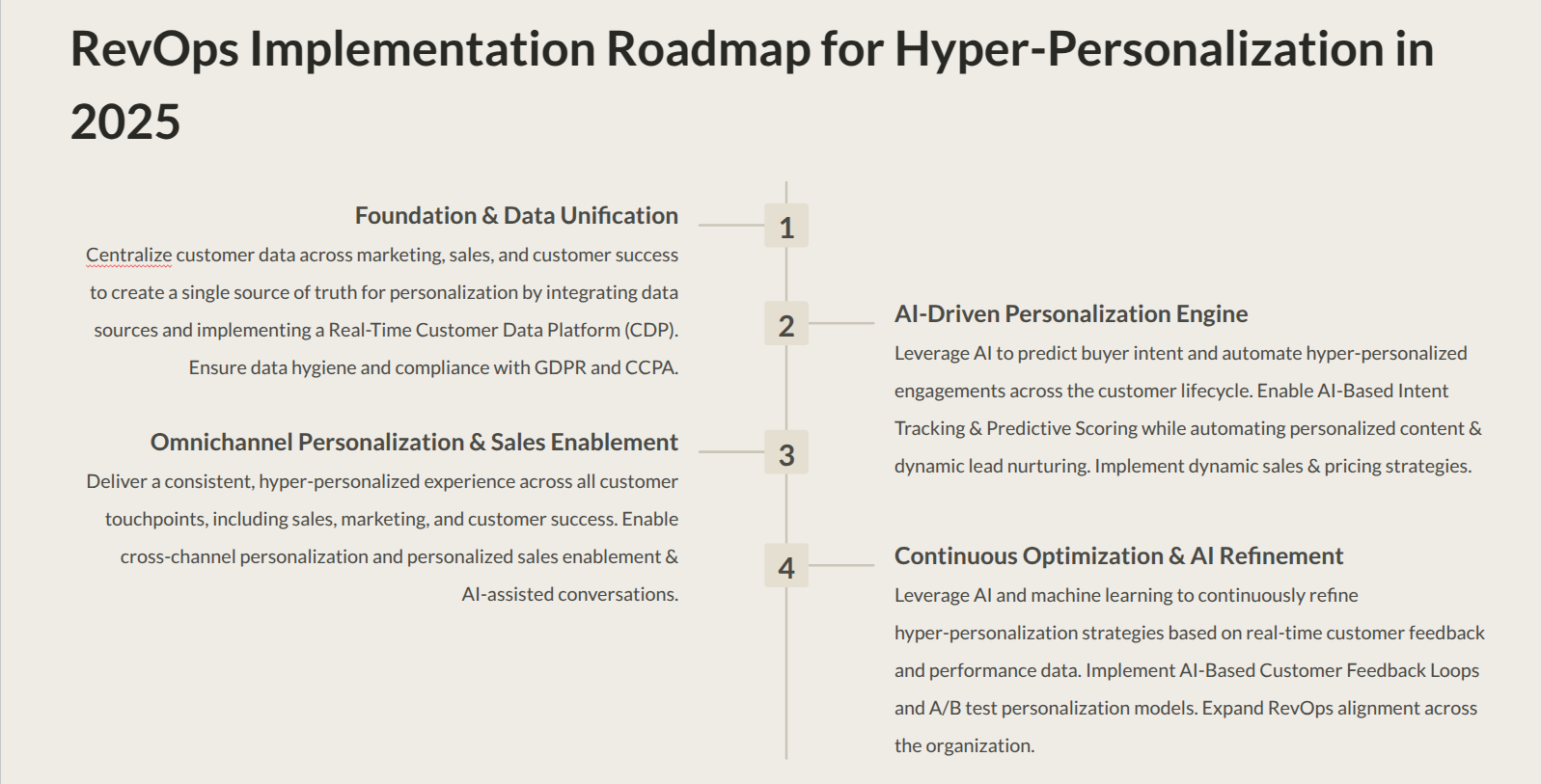Supercharging Personalization: RevOps Strategies for 2025
Introduction
In 2025, B2B buyers demand the same level of personalization they experience as consumers. They expect sellers to anticipate their needs, provide relevant content, and streamline decision-making with AI-driven insights. However, scaling personalization across thousands of accounts while maintaining efficiency remains a challenge.

This is where Revenue Operations (RevOps) becomes critical. By integrating data, automation, and AI-driven decision-making, RevOps teams enable seamless, hyper-personalized touchpoints across the entire customer lifecycle. This article explores how RevOps powers hyper-personalization at scale and why it’s a defining theme for 2025.
The Rise of Hyper-Personalization in 2025
Changing Buyer Expectations
B2B buyers now engage with sellers long after conducting their own research. Gartner reports that buyers spend only 17% of their time talking to sales reps. The rest is spent consuming personalized content, analyzing peer reviews, and testing self-service demos.
Companies that fail to personalize outreach risk losing engagement before sales even begin.
AI & Automation Take Center Stage
AI-driven platforms like Salesforce Einstein and HubSpot AI analyze customer behavior in real-time, dynamically adjusting content, email sequences, and sales cadences.
In 2025, AI doesn’t just predict customer intent—it automatically tailors the next interaction based on past engagement.
Data Privacy & First-Party Strategies
With third-party cookies being phased out, companies like Adobe and Snowflake are focusing on first-party data strategies, collecting direct user data via customer portals and engagement tracking.
RevOps ensures businesses build personalization engines while remaining compliant with privacy laws like GDPR and CCPA.
Top Tool Recommendations for RevOps-Led Personalization
- AI-Powered CRM & Data Platforms: HubSpot, Salesforce Revenue Cloud, Microsoft Dynamics 365
- Predictive Analytics & Intent Data: 6sense, ZoomInfo, Gong.io
- Automation & AI-Powered Personalization: Drift, Outreach.io, Marketo Engage
- Revenue & Sales Optimization: Clari, Chili Piper, PandaDoc
- Customer Success & Retention: Gainsight, Totango, Zendesk
RevOps Implementation Roadmap for Hyper-Personalization
Phase 1: Foundation & Data Unification
Centralize customer data across marketing, sales, and customer success for a unified personalization strategy.
Phase 2: AI-Driven Personalization Engine
Leverage AI for predictive engagement, automated nurturing, and dynamic content delivery.
Phase 3: Omnichannel Personalization & Sales Enablement
Deliver hyper-personalized experiences across multiple customer touchpoints.
Phase 4: Continuous Optimization & AI Refinement
Use AI and analytics to refine hyper-personalization strategies in real time.
RevOps Implementation Roadmap - Ideas for KPIs

Phase 1: Foundation & Data Unification
Goal: Centralize customer data across marketing, sales, and customer success to create a single source of truth for personalization.
- Audit & Integrate Data Sources (CRM, sales engagement, marketing data)
- Implement Real-Time Customer Data Platform (CDP) using AI-driven platforms
- Ensure Data Hygiene & Compliance with GDPR and CCPA
KPIs: Data accuracy rate > 90% (ideally more like 95%+), 95% reduction in duplicate records, mechanism in place to surface these artifacts to let you know if your work is improving the system.
Phase 2: AI-Driven Personalization Engine
Goal: Leverage AI to predict buyer intent and automate hyper-personalized engagements.
- Enable AI-Based Intent Tracking & Predictive Scoring
- Automate Personalized Content & Dynamic Lead Nurturing
- Implement Dynamic Sales & Pricing Strategies
KPIs: 20-30% increase in lead-to-MQL conversions, 50%+ improvement in engagement rates, 15-20% faster deal closures.
Phase 3: Omnichannel Personalization & Sales Enablement
Goal: Deliver a consistent, hyper-personalized experience across all customer touchpoints.
- Enable Cross-Channel Personalization (email, chatbots, social platforms)
- Equip Sales Teams with AI-Powered Insights
- AI-Driven Customer Success & Retention Strategies
KPIs: 15-20% increase in deal size, 25-30% more meetings booked, 10-15% reduction in customer churn.
Phase 4: Continuous Optimization & AI Refinement
Goal: Use AI and machine learning to refine hyper-personalization strategies in real-time.
- Implement AI-Based Customer Feedback Loops
- Test & Optimize Personalization Models using A/B Testing
- Expand RevOps Alignment to Onboarding, Renewals, and Cross-Sell
KPIs: 20-25% improvement in upsell success rate, 30%+ CLV growth, 15-20% of revenue driven by AI-led personalization.
Future-Proofing Your RevOps Personalization Strategy
Here is a framework you can you use when thinking about how to implement personalization in your org:

- Invest in AI and data infrastructure
- Automate personalization at scale
- Enable cross-functional collaboration
- Measure and optimize continuously
Conclusion
By 2025, hyper-personalization will be a necessity in B2B sales. Companies leveraging RevOps to integrate AI, data, and automation will lead the industry with seamless customer experiences.
Next Steps: Audit your tech stack, align your teams, and leverage AI-driven insights to stay competitive. Don't forget - this is a marathon, not a sprint so go one piece at a time.